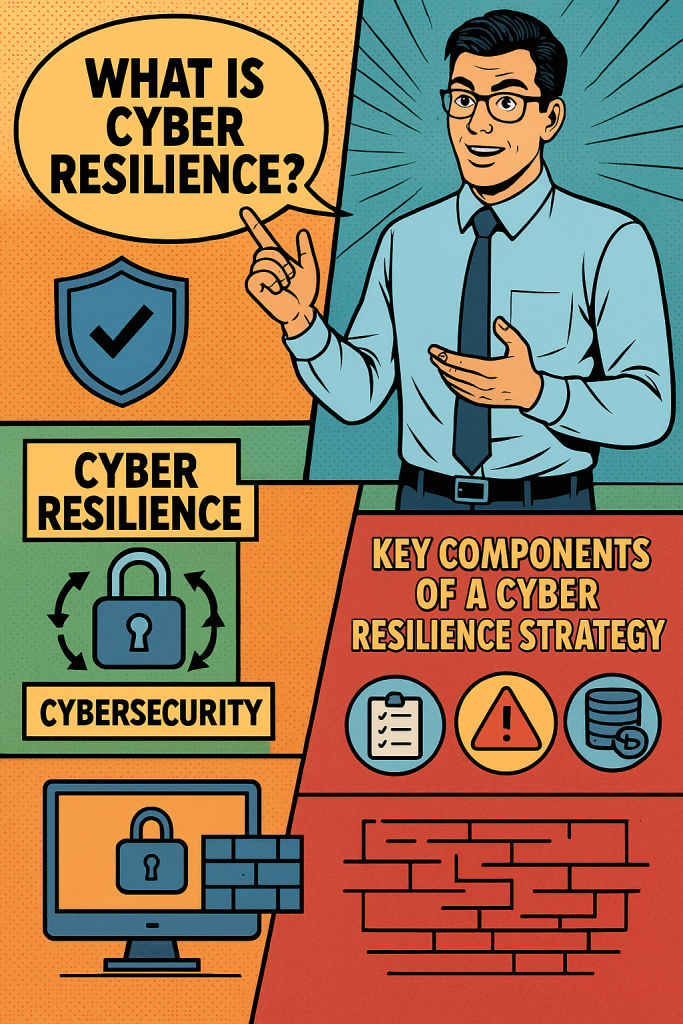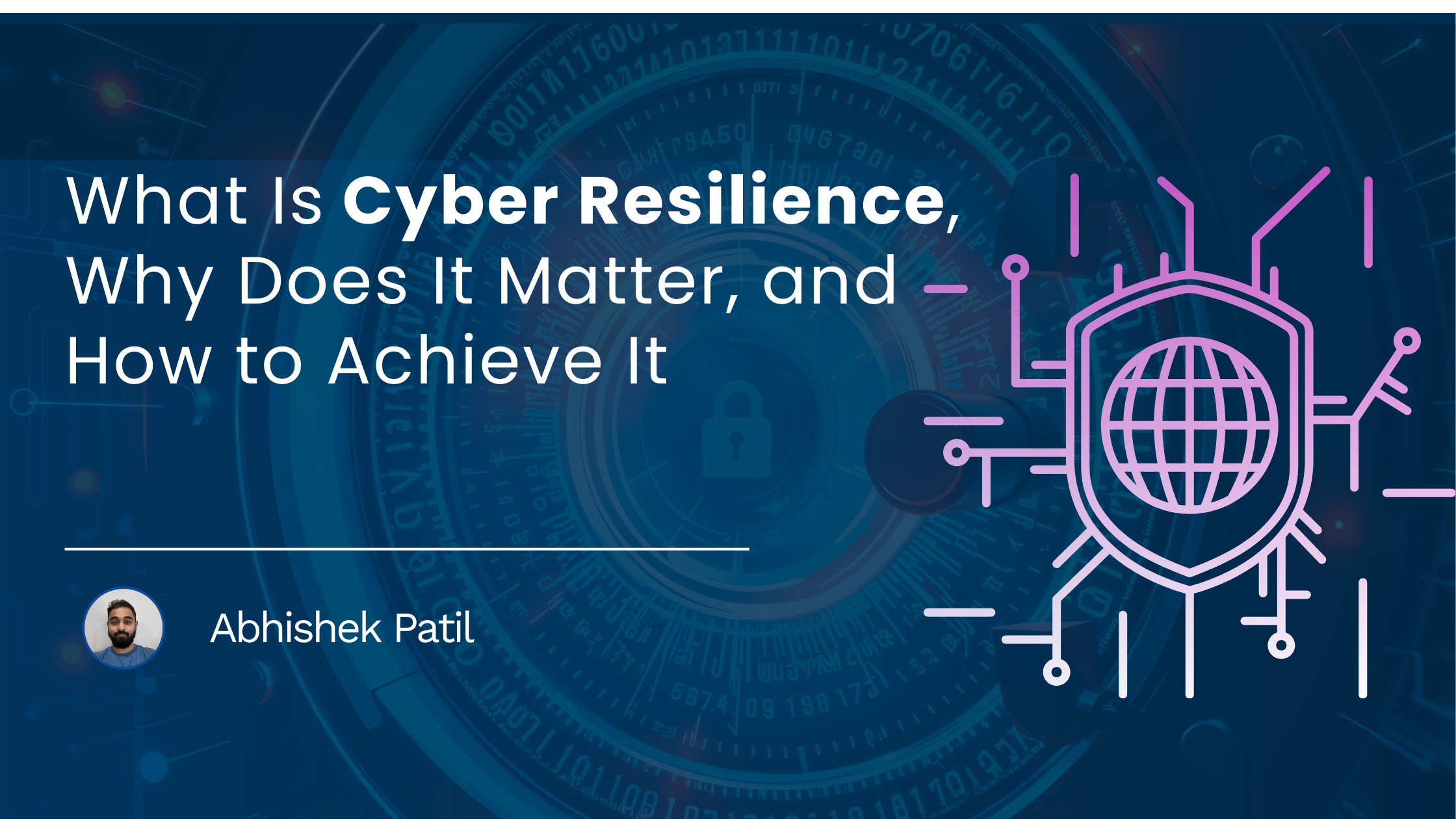Cyber resilience has emerged as a foundational strategy for organizations facing an onslaught of cyber threats. High-profile data breaches, ransomware attacks, and IT outages have made it clear that preventing attacks alone is not enough. Companies must also be able to withstand incidents and keep operating.
In this blog, we’ll discuss what cyber resilience means, how it differs from traditional cybersecurity, why it’s so important in 2025, and best practices for building a resilient cyber strategy.
Interested in improving your organization’s cyber resilience cost-effectively and with maximum ease? Schedule a demo with SecPod to see how our platform can help bolster your defenses and maintain business continuity.

What is Cyber Resilience?
Cyber resilience refers to an organization’s ability to prepare for, respond to, and recover from cyber incidents while continuing critical, revenue-generating operations. In practice, this means accepting that some attacks will inevitably get through and planning accordingly. A cyber-resilient business can minimize the impact of security incidents on its goals and services. For example, if ransomware strikes, a resilient company has data backups and recovery processes ready so that systems can be restored with minimal downtime. This concept blocks threats and maintains operational continuity despite attacks.
Cyber resilience is often discussed alongside cybersecurity, but the two terms are not the same. Cybersecurity focuses on protecting systems and data to prevent breaches — through firewalls, and encryption among other practices — whereas cyber resilience assumes some breaches will happen and emphasizes response and recovery. In other words, strong cybersecurity is necessary to achieve cyber resilience, but resilience also includes business continuity planning, disaster recovery, and learning from incidents.
Cyber Resilience vs. Cybersecurity
It’s important to understand the difference between cybersecurity and cyber resilience. Cybersecurity encompasses the tools, policies, and procedures an organization uses to protect itself from cyber threats; for example, controlling access to data and patching software vulnerabilities. In contrast, cyber resilience is about keeping the business running even when those defenses are breached. One way to think of it is that cybersecurity aims to prevent attacks, while cyber resilience focuses on surviving and adapting after an attack.
These concepts are closely linked and complementary. Effective cybersecurity reduces the likelihood of incidents, and robust resilience planning mitigates the damage if an incident occurs. Notably, certain threats target operations rather than stealing data. For instance, ransomware or DDoS attacks are intended to knock systems offline. Cyber resilience strategies specifically address such disruptive attacks by ensuring you can recover quickly and maintain important functions, whereas traditional security measures might focus more on preventing data theft. In short, organizations today must have plans for both: strong security to guard against intrusions, and resilience plans to limit downtime and business impact when incidents happen.
Why Cyber Resilience Matters in 2025
Cyber resilience has become a top priority for business leaders because the stakes of cyber attacks are higher than ever. In 2024, the average cost of a data breach reached $4.88 million, a 10% increase from the previous year. Major incidents can halt operations and incur huge losses. One analysis found that in 2024, downtime cost organizations an average of $14,000 per minute, rising to $23,750 per minute for large enterprises. These figures underscore how a single cyber incident can ripple through supply chains, disrupt services, and damage the bottom line. Investing in cyber resilience can significantly reduce the economic impact of cyber events, and studies show more resilient companies even deliver higher shareholder returns than less resilient peers.
Equally important are the intangible benefits of cyber resilience. A company that can handle incidents gracefully is more likely to preserve customer trust and protect its reputation. Publicly, regulators and customers are increasingly expecting transparency and swift recovery when breaches occur. For pivotal infrastructure sectors like energy, finance, and healthcare, resilience is directly tied to public safety and national security. On the flip side, organizations lacking resilience face greater legal and compliance risks if a breach spirals out of control.
The modern threat environment also makes cyber resilience inevitable. Cyber attacks are growing more sophisticated, where threat actors leverage automation and even generative AI to outpace traditional defenses. As global tensions rise and attackers evolve ransomware tactics, risks in 2025 are intensifying. Traditional security alone is no longer sufficient when new vulnerabilities and attack methods emerge so rapidly. By prioritizing resilience, organizations make sure they can adapt to evolving threats and continue to operate under duress. To sum it up, cyber resilience matters because it enables businesses to survive and thrive despite the increasingly challenging cyber landscape.
The Main Components of a Cyber Resilience Strategy
Building cyber resilience requires a multi-faceted approach. There is no single tool or policy that guarantees resilience. Instead, organizations need a combination of preparations and capabilities across several areas:
Preparation and Prevention
A solid resilience strategy starts long before any incident. Risk management and prevention measures help reduce the likelihood and potential impact of attacks. This includes identifying critical assets and threats, performing regular vulnerability assessments, and keeping systems up to date with patches, a practice often called maintaining good cyber hygiene. By addressing known weaknesses proactively, you lower the chances of a crippling breach. Employee training is also very important because a workforce educated in security awareness can prevent many incidents, like spotting phishing attempts, from occurring in the first place.
Detection and Incident Response
No organization can block 100% of threats, so the next component is the ability to detect incidents quickly and respond effectively. This involves continuous security monitoring via tools like intrusion detection systems or SIEMs to catch suspicious activity early. It also means having a well-defined incident response plan that outlines how to contain an attack and notify the right teams. Regular incident response drills or simulations can ensure your team is ready to act under pressure. When a cyber incident strikes, swift and coordinated response is vital to limit damage. Companies that detect breaches faster and react decisively will suffer far less disruption.
Recovery and Continuity Plans
A cornerstone of cyber resilience is having robust disaster recovery and business continuity plans, which typically means preparing for worst-case scenarios. They may include widespread ransomware outage by backing up critical data and systems. Data backups should be performed frequently and stored securely offsite, with periodic tests to verify you can restore them. Similarly, continuity planning may include having redundant systems, failover processes, or manual workarounds so that essential services can continue during an IT outage. The goal is to minimize downtime. If an attack takes one system offline, a resilient organization can switch to alternates and keep operating. Quick recovery capabilities also deter attackers’ objectives; for instance, effective backups can nullify a ransom demand by allowing you to restore data without paying.
Learning and Adaptation
True cyber resilience is an ongoing process of learning and improving. Every incident or near-miss should be analyzed for lessons. After recovering from an attack, resilient organizations conduct post-incident reviews to determine what happened and how to prevent it from happening again. This could lead to updating security controls, patching previously unknown vulnerabilities, or revising response plans. Sharing lessons learned across the industry through information-sharing groups or partnerships can further strengthen defenses. A cyber-resilient culture treats each event as feedback to adapt strategies and become even more resilient. Over time, this continuous improvement cycle makes the organization much harder to knock down.
Best Practices to Build Cyber Resilience
Achieving cyber resilience involves implementing a range of best practices across people, processes, and technology. Here are some practical steps and measures organizations should take:
- Maintain Strong Cyber Hygiene: Consistently apply security basics like timely patching of software, using anti-malware tools, and enforcing solid access controls. Good cyber hygiene drastically reduces avoidable incidents. For a comprehensive checklist, see our Cyber Hygiene Checklist for 2025.
- Conduct Regular Vulnerability Assessments: Proactively scan for and remediate weaknesses in your networks and applications. Identifying vulnerabilities before attackers do is critical. Incorporating continuous vulnerability assessment — as outlined in the SecPod blog on the role of vulnerability assessment in cyber resilience — helps ensure that high-risk exposures are addressed, thereby improving your overall resilience.
- Backup Data and Test Recovery Procedures: Back up important data and system images frequently, and test those backups by performing trial recoveries. Regular testing helps you actually restore operations quickly after an incident. Many organizations automate daily backups and conduct disaster recovery drills to build confidence in their recovery capabilities.
- Implement Network Segmentation and Zero Trust: Limit the blast radius of attacks by segmenting networks and adopting a zero-trust mindset; never implicitly trust any device or user by default. If an attacker breaches one segment, segmentation prevents them from easily moving laterally to other critical systems. Zero Trust architectures, where every access request is verified, can significantly contain breaches and help maintain control during an incident.
- Develop and Update an Incident Response Plan: Have a clear incident response plan that details roles, communication flow, and steps to take during various incident scenarios. This plan should be updated at least annually or after major incidents and practiced through tabletop exercises. When everyone knows their role and the plan is rehearsed, the actual response to an incident will be far more effective and rapid.
- Foster a Cyber Resilience Culture: Encourage an organizational mindset that values resilience. Such a practice includes executive support for cybersecurity initiatives, cross-department collaboration, and employee empowerment to report issues. A culture of resilience guarantees that everyone — not just IT staff — is prepared to handle disruptions and adapt as needed.
Following these best practices can empower organizations to significantly boost their ability to withstand and bounce back from cyber adversity. The objective is to be proactive: assume that breaches will happen and take steps now to reduce their impact. Every preventive action, from patching a server to training an employee, is an investment in resilience that could save your business when an incident occurs. To see how SecPod can help bolster your organization’s cyber resilience, schedule a demo today. Our experts can guide you through building a stronger security and compliance posture to keep your business running securely.

